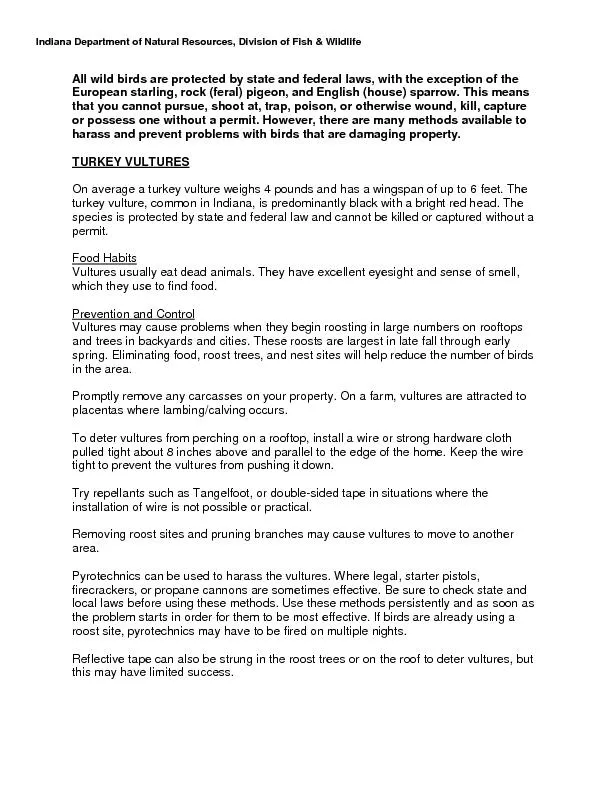

httpswwwaphisusdagovpublicationswildlifedamagecontentprintableversionfsv ulturedamagemanpdf Indiana Department of Natural Resources Division of Fish WildlifeAll wild birds are pr ID: 454334
Download Pdf The PPT/PDF document "Indiana Department of Natural Resources,..." is the property of its rightful owner. Permission is granted to download and print the materials on this web site for personal, non-commercial use only, and to display it on your personal computer provided you do not modify the materials and that you retain all copyright notices contained in the materials. By downloading content from our website, you accept the terms of this agreement.
��Indiana Department of Natural Resources, Division of Fish & Wildlifethese preventive and harassment measures fail, and you are still experiencing significantproblems due to vultures, contact the Indiana DNR (Linnea Petercheff at 3176527) and U.Sish and ildlife ervicefor permits to lethally removethe birds.For more information about the prevention and control of turkey vultures, please go to: https://www.aphis.usda.gov/publications/wildlife_damage/content/printable_version/fs_v ulture_damage_man.pdf ��Indiana Department of Natural Resources, Division of Fish & WildlifeAll wild birds are protected by state and federal laws, with the exception of the European starling, rock (feral) pigeon, and English (house)sparrow. This means that you cannot pursue, shoot at, trap, poison, or otherwise wound, kill, capture or possessone without a permit. However, there are many methods available to harass and prevent problems with birds that are damaging property. TURKEY VULTURES On average a turkey vulture weighs 4 poundsand has a wingspan of up to 6 feet. The turkeyvulture, common in Indiana, is predominantly black with a bright red head. The species isprotected by state and federal law and cannot be killed or captured without a permit. Food Habits Vultures usually eat dead animals. They have excellenteyesight and sense of smellwhich they use to find food. Prevention and Control Vultures may cause problems when they begin roosting in large numbers on rooftops and trees in backyards and cities. These roosts are largest in late fall through early spring. Eliminating food, roost trees, and nest sites will help reduce the number of birds in the area.Promptly remove any carcasses on your property. On a farm, vultures are attracted to placentas where lambing/calvingoccurs. To deter vultures from perching on a rooftop, install a wire or strong hardware cloth pulled tight about 8 inches above and parallel to the edge of the home. Keep the wire tight to prevent the vultures from pushing it down.Try repellantssuch as Tagelfoot, or doublesided tape in situations where the installationof wire is possible or practical.Removing roost sites and pruning branches may cause vultures to move to another area. Pyrotechnics can be used to harass the vultures. Where legal, starter pistolsfirecrackers, or propane cannons are sometimes effective. Be sure to check state and local laws before using these methods. Use these methods persistently and as soon as the problem startin order for them to be mosteffective. If birds are already using a roost site, pyrotechnics may have to be fired on multiplenights.eflective tae can also be strung in the roost trees or on the roof to detervultures, but this may have limited success.